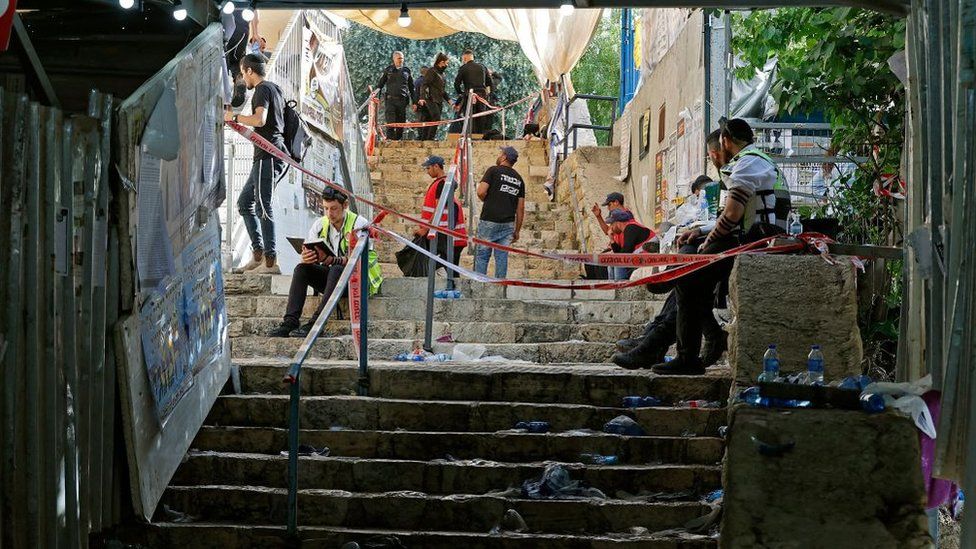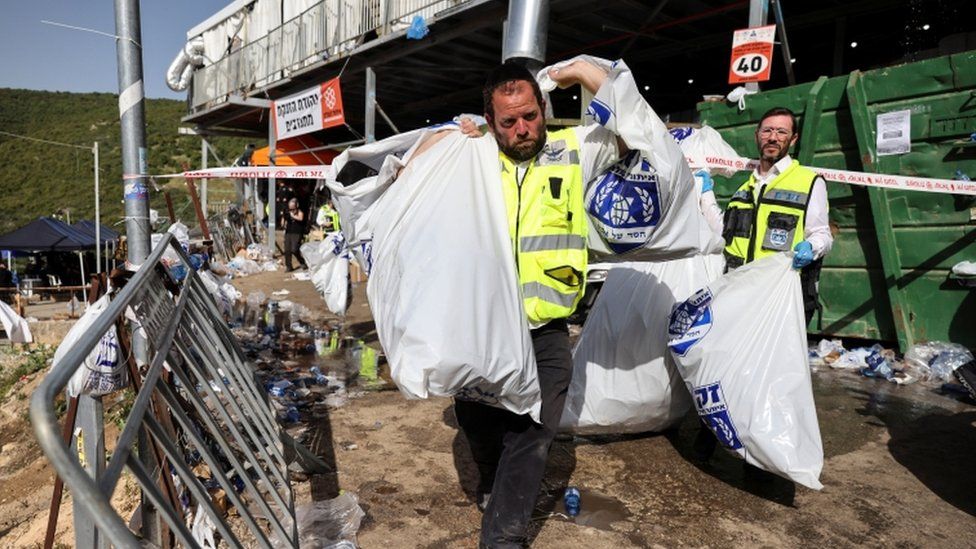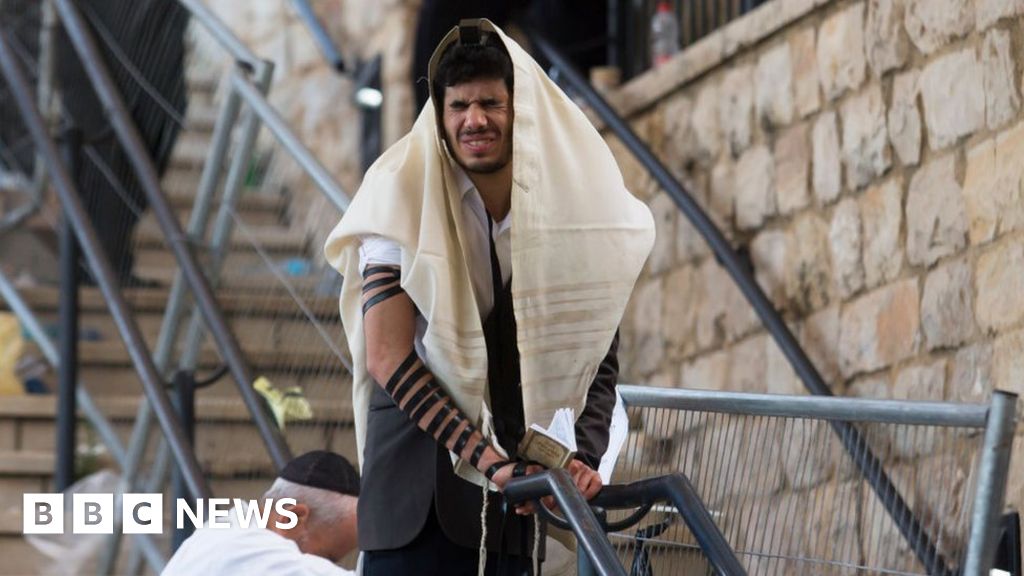Israel’s Prime Minister Benjamin Netanyahu has promised to investigate a crush at a crowded religious festival that left at least 45 people dead.
Visiting the scene near Mount Meron, he said it was one of the worst disasters the country had known and an inquiry would ensure it did not happen again.
Some 150 people were also injured at the all-night Lag B’Omer festival.
It seems a crush began when some people leaving the Orthodox Jewish event slipped in an overcrowded passageway.
One man who gave his name as David told Ynet news it had felt like a human wave had broken: “Our bodies were swept along by themselves. People were thrown up in the air – others were crushed on the ground.”
Medics struggled to reach the injured in the ensuing chaos.
Sunday has been declared a national day of mourning.
How did the disaster happen?
The site includes several large gathering grounds with open-air stands and stages, connected by a network of alleyways and other paths. It was along one of those paths where witnesses said the crush of people began at around 01:00 local time (22:00 GMT Thursday).
Some witnesses said the incident had begun when police closed the passageway, said to be 3m (10ft) wide. Police sources told Haaretz newspaper some people had slipped on steps, causing dozens more to fall over. This was not officially confirmed.
An injured man lying on a hospital bed said a line of people in the front of the surging crowd had simply collapsed.

“A pyramid of one on top of another was formed,” the unnamed man was quoted as saying by Reuters news agency. “People were piling up one on top of the other. I was in the second row. The people in the first row – I saw people die in front of my eyes.”
Dov Maisel, director of operations for volunteer-based emergency services organisation United Hatzalah, told the BBC he had never witnessed such a scene in his 30-year career.
“It felt like a surreal scene where we had over 20 people undergoing CPR by our teams, with limited ability to evacuate from the scene, simply because the place was too overwhelmed with people,” he said.
Witnesses say a police barricade prevented people from leaving the crowded area.
Israel’s state watchdog, the State Comptroller’s office, issued warnings in 2008 and 2011 of the risk of a disaster.
Special danger was posed by access roads and paths which “are narrow and not appropriate to accommodate the hundreds of thousands of people who visit the site”, the office was quoted as saying by the New York Times.
What was different this year was that bonfire areas were partitioned off as a Covid-19 precaution and this may have created unexpected choke-points for foot traffic, Reuters reports, quoting Israeli media.
Thousands of police officers were deployed to the area, and they closed down the event after the crush before helping evacuate attendees.
How did the police respond?
Investigators will look into whether there was any police misconduct connected to the disaster, the justice ministry said.
Mr Netanyahu promised a “serious” investigation that “would ensure this kind of disaster never happens again”.

Regional police chief Shimon Lavi told reporters at the scene he took upon himself “the overall responsibility, for good and for bad” and was “ready for every inspection”.
He later told AFP news agency his officers had done all they could on a “tragic night”. Other police officials told local media people had slipped in the walkway and the crush had been “out of their control”.
An unnamed police source told Haaretz the incident could not have been prevented and the police were not to blame.


At the disaster site, men come in their dozens. Some pray. Others stand in groups, exchange short words and point to where tragedy unfolded.
I walk down the ramp from the top of the slope where the crowd swelled. It is made of metal, with no steps, and eyewitness say it was wet and slippery.
Then the narrow passageway turns hard to the right and there are steep steps. One man points down them. “The police, they put barriers there!” he says, anger rising in his voice.
People say they could not get out as the crowd at the top, unaware, carried on coming.
Jewish pilgrims travel here in their hundreds of thousands for blessings at the shrine of a rabbi from antiquity. Instead, this year they met panic and a deadly crush.
And now this holy site witnesses an unplanned, mass evacuation. The festival was cancelled, and people are being bused out in their tens of thousands.

How has the outside world reacted?
White House national security adviser Jake Sullivan tweeted: “Our hearts go out to the people of Israel tonight following the terrible tragedy at Mount Meron. We offer our condolences to the families and friends who lost loved ones in this disaster, and wish a full and swift recovery to those injured.”
“My thoughts are with the Israeli people and those who have lost loved ones in this tragedy,” UK Prime Minister Boris Johnson said on Twitter.
German Chancellor Angela Merkel described the crush as a “catastrophe” and offered her “heartfelt sympathies”.
The EU, as well as leaders from India, Austria and elsewhere, also offered their condolences.

What is the Lag B’Omer festival?
Tens of thousands of Orthodox Jews make a pilgrimage to Meron each year for Lag B’Omer, a religious holiday marked with all-night bonfires, prayer and dancing.
The town is the site of the tomb of Rabbi Shimon Bar Yochai, a revered Second-Century sage, who ordained that the anniversary of his death be commemorated with a celebration of his life.
Israel’s successful vaccination programme has allowed it to lift many restrictions, but health officials had still warned of the risk of Covid-19.

The site is mostly gender-segregated. Images and video suggest the crush happened in one of the men’s sections.
According to the Times of Israel, organisers estimated that 100,000 people arrived on Thursday night.
Attendance was higher than last year, when the festival was held under restrictions due to the coronavirus pandemic.
But it was still smaller than in previous years, when hundreds of thousands of people took part.

Were you in the area? Did you witness what happened? Share your experiences by emailing haveyoursay@bbc.co.uk.
Please include a contact number if you are willing to speak to a BBC journalist. You can also get in touch in the following ways:
- WhatsApp: +44 7756 165803
- Tweet: @BBC_HaveYourSay
- Upload pictures or video
- Please read our terms & conditions and privacy policy
